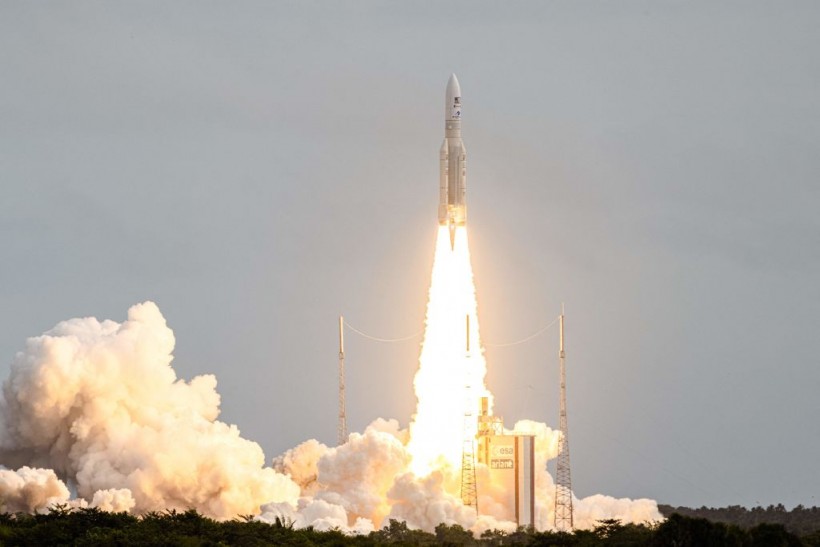The Juice satellite, which was eagerly awaited in Europe, has finally been launched after a successful second attempt. The spacecraft, weighing six tonnes, was carried into space on an Ariane 5 rocket from the Kourou spaceport in French Guiana at 13:14 BST (09:14 local time) on April 14.
The launch of the mission was presented life via ESA Web TV and the European Space Agency's YouTube channel, or the link provided below.

This photograph taken on April 14, 2023, shows Arianespace's Ariane 5 rocket lifting off from its launchpad, at the Guiana Space Center in Kourou, French Guiana.
Beginning of Juice Satellite's Eight-year Journey to the Jovian System
The Juice satellite is a spacecraft intended to explore Jupiter's icy moons that were launched using a similar rocket as the one that launched the James Webb Space Telescope (JWST), MailOnline reported.
Its launch process saw the Ariane 5's solid rocket fuel boosters detach, followed by other stages of the rocket, with full separation achieved after 28 minutes. The Juice probe was located in the cone at the top of the rocket, which split in two and separated as part of the launch process.
Half an hour after launch, scientists received a signal indicating that Juice had started functioning, and the spacecraft was controlled by ESA engineers.
With Juice operational, its solar arrays were deployed first, followed by the movement of its antennas and magnetometer boom into position. However, the Ariane rocket could not launch the spacecraft directly to Jupiter so a gravitational slingshot technique will be used.
A series of flybys of Venus and Earth will help the spacecraft achieve the required propulsion for its intended destination. The estimated cost of Juice is $1.7 billion (£1.4 billion), with UK Space Agency contributing $11 million (£9 million). The spacecraft will travel 4.1 billion miles (6.6 billion km) to reach Jupiter's icy moons, completing the journey in 8.5 years and arriving in July 2031.
READ ALSO: ESA Juice Mission: Jupiter Icy Moons Explorer Passes Atomic Oxygen Test Ahead of Journey
Studying the Jovian System in Search of Extraterrestrial Life
The Juice satellite will begin studying Jupiter's system six months out using its ten powerful scientific instruments, according to ESA. These include an optical camera system, spectrometers, and a magnetometer, among others.
Upon reaching Jupiter, JUICE will make close observations of Ganymede, Callisto, and Europa with 35 flybys between 2031 and 2034. JUICE will fly by Ganymede 12 times before entering its orbit, marking the first time a spacecraft will orbit a planetary moon other than Earth. After completing its mission, JUICE will crash land on Ganymede's icy surface.
Scientific American reported that the spacecraft will investigate the gas giant and its icy moons, particularly Ganymede, Europa, and Callisto, potentially inhabitable icy ocean worlds. Its primary objective is to learn more about the liquid water beneath their surfaces.
Scientists anticipate Juice's findings will keep them busy across a variety of fields for many years. The spacecraft's technology is the most extensive and sensitive ever flown to the outer solar system, and it will provide unprecedented data about the Jovian system.
However, it is not focusing on Io, Jupiter's fourth and innermost Galilean moon, as it is not an icy ocean world. Io is the most volcanic body in the solar system, generating significant frictional heat due to the gravitational pull of Jupiter and its other three Galilean moons.
RELATED ARTICLE: Juice Satellite Set To Launch This Week To Investigate Jupiter's Large Ocean-bearing Moons
Check out more news and information on Space in Science Times.










!['Cosmic Glitch' in Einstein's Theory of General Relativity Could Be Explained in This New Scientific Tweak [Study]](https://1721181113.rsc.cdn77.org/data/thumbs/full/53435/258/146/50/40/cosmic-glitch-in-einsteins-theory-of-general-relativity-could-be-explained-in-this-new-scientific-tweak-study.jpeg)



